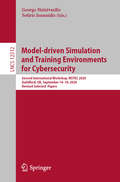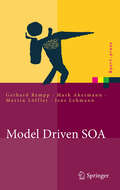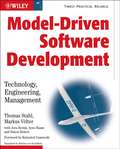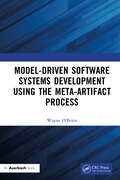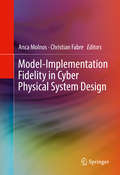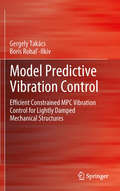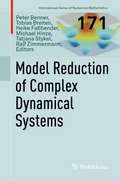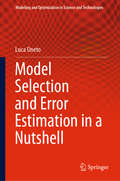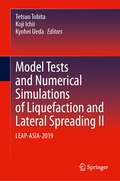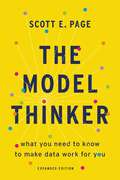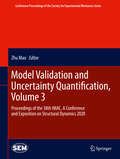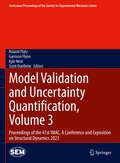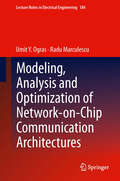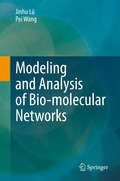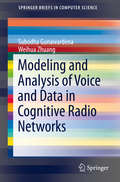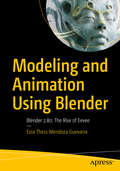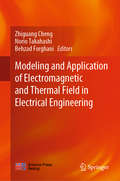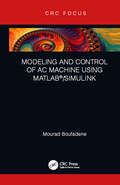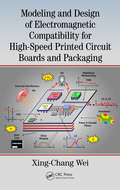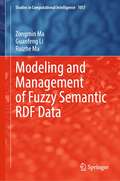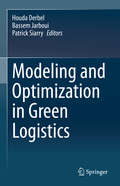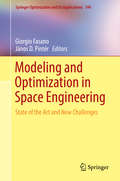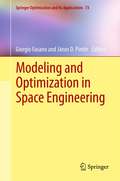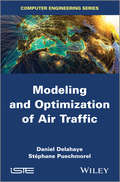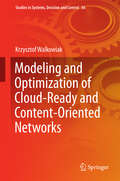- Table View
- List View
Model-driven Simulation and Training Environments for Cybersecurity: Second International Workshop, MSTEC 2020, Guildford, UK, September 14–18, 2020, Revised Selected Papers (Lecture Notes in Computer Science #12512)
by George Hatzivasilis Sotiris IoannidisThis book constitutes the refereed post-conference proceedings of the Second International Workshop on Model-Driven Simulation and Training Environments for Cybersecurity, MSTEC 2020, held in Guildford, UK, in September 2020 in conjunction with the 24th European Symposium on Research in Computer Security, ESORICS 2020. The conference was held virtually due to the COVID-19 pandemic. The MSTEC Workshop received 20 submissions from which 10 full papers were selected for presentation. The papers are grouped in thematically on: cyber security training modelling; serious games; emulation & simulation studies; attacks; security policies.
Model Driven SOA
by Gerhard Rempp Jens Lehmann Mark Akermann Martin LöfflerServiceorientierte Architektur (SOA) hat sich durchgesetzt, wer sie beherrscht, hat einen Wettbewerbsvorteil. Deshalb stellt sich meist nicht die Frage, ob SOA angewendet werden soll, sondern wie sie umgesetzt werden kann. Die Autoren geben anhand eines Anwendungsbeispiels einen Überblick über die modellgetriebene Softwareentwicklung. Sie zeigen, wie sich mit Modellierungsnotationen und mit Generatoren die werkzeuggestützte Entwicklung von SOA-Anwendungen effizient und dauerhaft umsetzen lässt. Mit allen notwendigen Sourcecodes und Dokumentationen.
Model-Driven Software Development
by Jorn Bettin Simon Helsen Markus Völter Arno Haase Thomas Stahl Krzysztof Czarnecki Bettina Von StockflethModel-Driven Software Development (MDSD) is currently a highly regarded development paradigm among developers and researchers. With the advent of OMG's MDA and Microsoft's Software Factories, the MDSD approach has moved to the centre of the programmer's attention, becoming the focus of conferences such as OOPSLA, JAOO and OOP.MDSD is about using domain-specific languages to create models that express application structure or behaviour in an efficient and domain-specific way. These models are subsequently transformed into executable code by a sequence of model transformations.This practical guide for software architects and developers is peppered with practical examples and extensive case studies. International experts deliver:* A comprehensive overview of MDSD and how it relates to industry standards such as MDA and Software Factories.* Technical details on meta modeling, DSL construction, model-to-model and model-to-code transformations, and software architecture.* Invaluable insight into the software development process, plus engineering issues such as versioning, testing and product line engineering.* Essential management knowledge covering economic and organizational topics, from a global perspective.Get started and benefit from some practical support along the way!
Model-Driven Software Systems Development Using the Meta-Artifact Process
by Wayne O'BrienThe importance of architecture for software systems is widely accepted, but the role of architecture in the overall development process is not so clear. Presenting an architecture-centric process, Model-Driven Software Systems Development Using the Meta-Artifact Process makes the role of architecture clear. At its core, this book is about developing software systems and, more specifically, software code. It describes three major innovations for making software, which are combined with five widely used enabling technologies, to provide a complete, hypothesis-driven software development process known as Meta-Artifact Process (MAP). Having complete requirements is essential for making good software and supports the hypothesis-driven MAP.MAP offers properties, qualities, and capabilities that help stakeholders and developers understand and reason about a domain and target systems of interest. MAP, through the central role of the Meta-Artifact and incorporating the view that a computer program is a hypothesis about the requirements, offers new ways to look at systems and their development, even changing the roles of developers and stakeholders.Recommending agile methods wherever appropriate while supporting the OMG Essence standard and working within an overarching architecture, MAP presents ways to ensure that the requirements are complete and correct. It helps to identify likely points during development to form alternative hypotheses about them. Because MAP requires an underlying software development process, it can provide that clarity to existing processes in which the organization’s developers are already proficient.This book provides concrete examples from two broad but diverse areas—Accounting Information Systems in the commercial area and a military command and control system—to show the wide applicability of MAP in both commercial and defense domains.
Model-Implementation Fidelity in Cyber Physical System Design
by Anca Molnos Christian FabreThis book puts in focus various techniques for checking modeling fidelity of Cyber Physical Systems (CPS), with respect to the physical world they represent. The authors' present modeling and analysis techniques representing different communities, from very different angles, discuss their possible interactions, and discuss the commonalities and differences between their practices. Coverage includes model driven development, resource-driven development, statistical analysis, proofs of simulator implementation, compiler construction, power/temperature modeling of digital devices, high-level performance analysis, and code/device certification. Several industrial contexts are covered, including modeling of computing and communication, proof architectures models and statistical based validation techniques.
Model Predictive Vibration Control
by Boris Rohaľ-Ilkiv Gergely TakácsReal-time model predictive controller (MPC) implementation in active vibration control (AVC) is often rendered difficult by fast sampling speeds and extensive actuator-deformation asymmetry. If the control of lightly damped mechanical structures is assumed, the region of attraction containing the set of allowable initial conditions requires a large prediction horizon, making the already computationally demanding on-line process even more complex. Model Predictive Vibration Control provides insight into the predictive control of lightly damped vibrating structures by exploring computationally efficient algorithms which are capable of low frequency vibration control with guaranteed stability and constraint feasibility. In addition to a theoretical primer on active vibration damping and model predictive control, Model Predictive Vibration Control provides a guide through the necessary steps in understanding the founding ideas of predictive control applied in AVC such as: · the implementation of computationally efficient algorithms · control strategies in simulation and experiment and · typical hardware requirements for piezoceramics actuated smart structures. The use of a simple laboratory model and inclusion of over 170 illustrations provides readers with clear and methodical explanations, making Model Predictive Vibration Control the ideal support material for graduates, researchers and industrial practitioners with an interest in efficient predictive control to be utilized in active vibration attenuation.
Model Reduction of Complex Dynamical Systems (International Series of Numerical Mathematics #171)
by Peter Benner Tobias Breiten Heike Faßbender Michael Hinze Tatjana Stykel Ralf ZimmermannThis contributed volume presents some of the latest research related to model order reduction of complex dynamical systems with a focus on time-dependent problems. Chapters are written by leading researchers and users of model order reduction techniques and are based on presentations given at the 2019 edition of the workshop series Model Reduction of Complex Dynamical Systems – MODRED, held at the University of Graz in Austria. The topics considered can be divided into five categories:system-theoretic methods, such as balanced truncation, Hankel norm approximation, and reduced-basis methods; data-driven methods, including Loewner matrix and pencil-based approaches, dynamic mode decomposition, and kernel-based methods;surrogate modeling for design and optimization, with special emphasis on control and data assimilation;model reduction methods in applications, such as control and network systems, computational electromagnetics, structural mechanics, and fluid dynamics; andmodel order reduction software packages and benchmarks.This volume will be an ideal resource for graduate students and researchers in all areas of model reduction, as well as those working in applied mathematics and theoretical informatics.
Model Selection and Error Estimation in a Nutshell (Modeling and Optimization in Science and Technologies #15)
by Luca OnetoHow can we select the best performing data-driven model? How can we rigorously estimate its generalization error? Statistical learning theory answers these questions by deriving non-asymptotic bounds on the generalization error of a model or, in other words, by upper bounding the true error of the learned model based just on quantities computed on the available data. However, for a long time, Statistical learning theory has been considered only an abstract theoretical framework, useful for inspiring new learning approaches, but with limited applicability to practical problems. The purpose of this book is to give an intelligible overview of the problems of model selection and error estimation, by focusing on the ideas behind the different statistical learning theory approaches and simplifying most of the technical aspects with the purpose of making them more accessible and usable in practice. The book starts by presenting the seminal works of the 80’s and includes the most recent results. It discusses open problems and outlines future directions for research.
Model Tests and Numerical Simulations of Liquefaction and Lateral Spreading II: LEAP-ASIA-2019
by Tetsuo Tobita Koji Ichii Kyohei UedaThis open access book presents work collected through the Liquefaction Experiments and Analysis Projects (LEAP) in 2019 (LEAP-ASIA-2019) following the LEAP-UCD-2017 whose results have been published as a first volume. In addition to the research targets set in the previous one, such as the repeatability, variability, and sensitivity of lateral spreading on mildly sloping liquefiable sand, this volume includes research efforts to validate the generalized scaling law (hereafter “GSL”) for the identical prototype with the one employed in UCD-2017. In LEAP-ASIA-2019, 10 institutes around the world conducted 23 tests in total. It was the first multi-institutional attempts to investigate the validity of the generalized scaling law for the saturated sandy sloping deposit with wide range of initial conditions. The experimental data provided a unique basis for assessing the capabilities of six different simulation platforms for numerical simulation of soil liquefaction. The results of the experiments and the numerical simulations are presented and discussed in papers submitted by the project participants.
The Model Thinker: What You Need to Know to Make Data Work for You
by Scott E. PageHow anyone can become a data ninja From the stock market to genomics laboratories, census figures to marketing email blasts, we are awash with data. But as anyone who has ever opened up a spreadsheet packed with seemingly infinite lines of data knows, numbers aren't enough: we need to know how to make those numbers talk. In The Model Thinker, social scientist Scott E. Page shows us the mathematical, statistical, and computational models--from linear regression to random walks and far beyond--that can turn anyone into a genius. At the core of the book is Page's "many-model paradigm," which shows the reader how to apply multiple models to organize the data, leading to wiser choices, more accurate predictions, and more robust designs. The Model Thinker provides a toolkit for business people, students, scientists, pollsters, and bloggers to make them better, clearer thinkers, able to leverage data and information to their advantage.
Model Validation and Uncertainty Quantification, Volume 3: Proceedings of the 38th IMAC, A Conference and Exposition on Structural Dynamics 2020 (Conference Proceedings of the Society for Experimental Mechanics Series)
by Zhu MaoModel Validation and Uncertainty Quantification, Volume 3: Proceedings of the 38th IMAC, A Conference and Exposition on Structural Dynamics, 2020, the third volume of nine from the Conference brings together contributions to this important area of research and engineering. The collection presents early findings and case studies on fundamental and applied aspects of Model Validation and Uncertainty Quantification, including papers on:Uncertainty Quantification in Material ModelsUncertainty Propagation in Structural DynamicsPractical Applications of MVUQAdvances in Model Validation & Uncertainty Quantification: Model UpdatingModel Validation & Uncertainty Quantification: Industrial ApplicationsControlling UncertaintyUncertainty in Early Stage DesignModeling of Musical InstrumentsOverview of Model Validation and Uncertainty
Model Validation and Uncertainty Quantification, Volume 3: Proceedings of the 41st IMAC, A Conference and Exposition on Structural Dynamics 2023 (Conference Proceedings of the Society for Experimental Mechanics Series)
by Roland Platz Garrison Flynn Kyle Neal Scott OuelletteModel Validation and Uncertainty Quantification, Volume 3: Proceedings of the 41st IMAC, A Conference and Exposition on Structural Dynamics, 2023, the third volume of ten from the Conference brings together contributions to this important area of research and engineering. The collection presents early findings and case studies on fundamental and applied aspects of Model Validation and Uncertainty Quantification, including papers on:Introduction of Uncertainty QuantificationUncertainty Quantification in DynamicsModel Form Uncertainty and Selection incl. Round Robin ChallengeSensor and Information FusionVirtual Sensing, Certification, and Real-Time MonitoringSurrogate Modeling
Modeling, Analysis and Optimization of Network-on-Chip Communication Architectures
by Umit Y. Ogras Radu MarculescuTraditionally, design space exploration for Systems-on-Chip (SoCs) has focused on the computational aspects of the problem at hand. However, as the number of components on a single chip and their performance continue to increase, the communication architecture plays a major role in the area, performance and energy consumption of the overall system. As a result, a shift from computation-based to communication-based design becomes mandatory. Towards this end, network-on-chip (NoC) communication architectures have emerged recently as a promising alternative to classical bus and point-to-point communication architectures. In this dissertation, we study outstanding research problems related to modeling, analysis and optimization of NoC communication architectures. More precisely, we present novel design methodologies, software tools and FPGA prototypes to aid the design of application-specific NoCs.
Modeling and Analysis of Bio-molecular Networks
by Jinhu Lü Pei WangThis book addresses a number of questions from the perspective of complex systems: How can we quantitatively understand the life phenomena? How can we model life systems as complex bio-molecular networks? Are there any methods to clarify the relationships among the structures, dynamics and functions of bio-molecular networks? How can we statistically analyse large-scale bio-molecular networks? Focusing on the modeling and analysis of bio-molecular networks, the book presents various sophisticated mathematical and statistical approaches. The life system can be described using various levels of bio-molecular networks, including gene regulatory networks, and protein-protein interaction networks. It first provides an overview of approaches to reconstruct various bio-molecular networks, and then discusses the modeling and dynamical analysis of simple genetic circuits, coupled genetic circuits, middle-sized and large-scale biological networks, clarifying the relationships between the structures, dynamics and functions of the networks covered. In the context of large-scale bio-molecular networks, it introduces a number of statistical methods for exploring important bioinformatics applications, including the identification of significant bio-molecules for network medicine and genetic engineering. Lastly, the book describes various state-of-art statistical methods for analysing omics data generated by high-throughput sequencing. This book is a valuable resource for readers interested in applying systems biology, dynamical systems or complex networks to explore the truth of nature.
Modeling and Analysis of Voice and Data in Cognitive Radio Networks
by Subodha Gunawardena Weihua ZhuangThis Springer Brief investigates the voice and elastic/interactive data service support over cognitive radio networks (CRNs), in terms of their delay requirements. The increased demand for wireless communication conflicts with the scarcity of the radio spectrum, but CRNS allow for more efficient use of the networks. The authors review packet level delay requirements of the voice service and session level delay requirements of the elastic/interactive data services, particularly constant-rate and on-off voice traffic capacities in CRNs with centralized and distributed network coordination. Some generic channel access schemes are considered as the coordination mechanism, and call admission control algorithms are developed for non-fully-connected CRNs. Other key topics include the advantages of supporting voice traffic flows with different delay requirements, the mean response time of the elastic data traffic over a centralized CRN, and effects of the traffic load at the base station and file length (service time requirement) distribution on the mean response time. The brief is designed for professionals and researchers working with wireless networks, cognitive radio, and communications. It is also a helpful reference for advanced-level students interested in efficient wireless communications.
Modeling and Animation Using Blender: Blender 2.80: The Rise of Eevee
by Ezra Thess GuevarraDiscover the 3D-modeling and animation power of Blender 3D. This book starts with a brief introduction to Blender 3D including installation and the user interface. The following two chapters then introduce you to the upgraded tools in Blender 2.80 for 3D modeling, texturing, shading, and animation. The last chapter discusses the Blender game engine and all its core features. Along the way you’ll see why Blender 3D has proved its competency in UV unwrapping, texturing, raster graphic editing, rigging, sculpting, animating, motion graphics, and video editing through the years. Modeling and Animation Using Blender gives a thorough tour of Blender Eevee, covering its new features and how to make best use of them. After reading this book you will have the confidence to choose Blender for your next project. What You Will Learn Master the features of Blender EeveeWork with modeling, animation, and much more using the updated softwareUnderstand important concepts such as physics and particles Who This Book Is For Art enthusiasts and professionals who want to learn Blender 3D. Blender 3D professionals who want to learn about the latest version would find the book useful.
Modeling and Application of Electromagnetic and Thermal Field in Electrical Engineering
by Zhiguang Cheng Norio Takahashi Behzad ForghaniCo-authored by an international research group with a long-standing cooperation, this book focuses on engineering-oriented electromagnetic and thermal field modeling and application. It presents important contributions, including advanced and efficient finite element analysis used in the solution of electromagnetic and thermal field problems for large and multi-scale engineering applications involving application script development; magnetic measurement of both magnetic materials and components under various, even extreme conditions, based on well-established (standard and non-standard) experimental systems; and multi-level validation based on both industrial test systems and extended TEAM P21 benchmarking platform. Although these are challenging topics, they are useful for readers from both academia and industry.
Modeling and Control of AC Machine using MATLAB®/SIMULINK
by Mourad BoufadeneThis book introduces electrical machine modeling and control for electrical engineering and science to graduate, undergraduate students as well as researchers, who are working on modeling and control of electrical machines. It targets electrical engineering students who have no time to derive mathematical equations for electrical machines in particular induction machine (IM) and doubly fed induction machines (DFIM). The main focus is on the application of field oriented control technique to induction motor (IM) and doubly fed induction motor (DFIM) in details, and since the induction motors have many drawback using this technique, therefore the application of a nonlinear control technique (feedback linearization) is applied to a reduced order model of DFIM to enhance the performance of doubly fed induction motor. Features Serves as text book for electrical motor modeling, simulation and control; especially modeling of induction motor and doubly fed induction motor using different frame of references. Vector control (field oriented control) is given in more detailed, and is applied to induction motor. A nonlinear controller is applied to a reduced model of an doubly induction motor associated with a linear observer to estimate the unmeasured load torque, which is used to enhance the performance of the vector control to doubly fed induction motor. Access to the full MATLAB/SIMULINK blocks for simulation and control.
Modeling and Design of Electromagnetic Compatibility for High-Speed Printed Circuit Boards and Packaging
by Xing-Chang WeiModeling and Design of Electromagnetic Compatibility for High-Speed Printed Circuit Boards and Packaging presents the electromagnetic modelling and design of three major electromagnetic compatibility (EMC) issues related to the high-speed printed circuit board (PCB) and electronic packages: signal integrity (SI), power integrity (PI), and electromagnetic interference (EMI). The emphasis is put on two essential passive components of PCBs and packages: the power distribution network and the signal distribution network. This book includes two parts. Part one talks about the field-circuit hybrid methods used for the EMC modeling, including the modal method, the integral equation method, the cylindrical wave expansion method and the de-embedding method. Part two illustrates EMC design methods and explores the applications of novel metamaterials and two-dimensional materials on traditional EMC problems. This book is designed to enhance worthwhile electromagnetic theory and mathematical methods for practical engineers and to train students with advanced EMC applications.
Modeling and Management of Fuzzy Semantic RDF Data (Studies in Computational Intelligence #1057)
by Zongmin Ma Guanfeng Li Ruizhe MaThis book systemically presents the latest research findings in fuzzy RDF data modeling and management. Fuzziness widely exist in many data and knowledge intensive applications. With the increasing amount of metadata available, efficient and scalable management of massive semantic data with uncertainty is of crucial importance. This book goes to great depth concerning the fast-growing topic of technologies and approaches of modeling and managing fuzzy metadata with Resource Description Framework (RDF) format. Its major topics include representation of fuzzy RDF data, fuzzy RDF graph matching, query of fuzzy RDF data, and persistence of fuzzy RDF data in diverse databases. The objective of the book is to provide the state-of-the-art information to researchers, practitioners, and postgraduates students who work on the area of big data intelligence and at the same time serve as the uncertain data and knowledge engineering professional as a valuable real-world reference.
Modeling and Optimization in Green Logistics
by Houda Derbel Bassem Jarboui Patrick SiarryThis book presents recent work that analyzes general issues of green logistics and smart cities. The contributed chapters consider operating models with important ecological, economic, and social objectives.The content will be valuable for researchers and postgraduate students in computer science, information technology, industrial engineering, and applied mathematics.
Modeling and Optimization in Space Engineering: State of the Art and New Challenges (Springer Optimization and Its Applications #144)
by Giorgio Fasano János D. PintérThis book presents advanced case studies that address a range of important issues arising in space engineering. An overview of challenging operational scenarios is presented, with an in-depth exposition of related mathematical modeling, algorithmic and numerical solution aspects. The model development and optimization approaches discussed in the book can be extended also towards other application areas. The topics discussed illustrate current research trends and challenges in space engineering as summarized by the following list: • Next Generation Gravity Missions • Continuous-Thrust Trajectories by Evolutionary Neurocontrol • Nonparametric Importance Sampling for Launcher Stage Fallout • Dynamic System Control Dispatch • Optimal Launch Date of Interplanetary Missions • Optimal Topological Design • Evidence-Based Robust Optimization • Interplanetary Trajectory Design by Machine Learning • Real-Time Optimal Control • Optimal Finite Thrust Orbital Transfers • Planning and Scheduling of Multiple Satellite Missions • Trajectory Performance Analysis • Ascent Trajectory and Guidance Optimization • Small Satellite Attitude Determination and Control • Optimized Packings in Space Engineering • Time-Optimal Transfers of All-Electric GEO Satellites Researchers working on space engineering applications will find this work a valuable, practical source of information. Academics, graduate and post-graduate students working in aerospace, engineering, applied mathematics, operations research, and optimal control will find useful information regarding model development and solution techniques, in conjunction with real-world applications.
Modeling and Optimization in Space Engineering
by Giorgio Fasano János D. PintérThis volume presents a selection of advanced case studies that address a substantial range of issues and challenges arising in space engineering. The contributing authors are well-recognized researchers and practitioners in space engineering and in applied optimization. The key mathematical modeling and numerical solution aspects of each application case study are presented in sufficient detail. Classic and more recent space engineering problems - including cargo accommodation and object placement, flight control of satellites, integrated design and trajectory optimization, interplanetary transfers with deep space manoeuvres, low energy transfers, magnetic cleanliness modeling, propulsion system design, sensor system placement, systems engineering, space traffic logistics, and trajectory optimization - are discussed. Novel points of view related to computational global optimization and optimal control, and to multidisciplinary design optimization are also given proper emphasis. A particular attention is paid also to scenarios expected in the context of future interplanetary explorations. Modeling and Optimization in Space Engineering will benefit researchers and practitioners working on space engineering applications. Academics, graduate and post-graduate students in the fields of aerospace and other engineering, applied mathematics, operations research and optimal control will also find the book useful, since it discusses a range of advanced model development and solution techniques and tools in the context of real-world applications and new challenges.
Modeling and Optimization of Air Traffic
by Daniel Delahaye Stéphane PuechmorelThis book combines the research activities of the authors, both of whom are researchers at Ecole Nationale de l’Aviation Civile (French National School of Civil Aviation), and presents their findings from the last 15 years. Their work uses air transport as its focal point, within the realm of mathematical optimization, looking at real life problems and theoretical models in tandem, and the challenges that accompany studying both approaches. The authors’ research is linked with the attempt to reduce air space congestion in Western Europe, USA and, increasingly, Asia. They do this through studying stochastic optimization (particularly artificial evolution), the sectorization of airspace, route distribution and takeoff slots, and by modeling airspace congestion. Finally, the authors discuss their short, medium and long term research goals. They hope that their work, although related to air transport, will be applied to other fields, such is the transferable nature of mathematical optimization. At the same time, they intend to use other areas of research, such as approximation and statistics to complement their continued inquiry in their own field. Contents 1. Introduction. Part 1. Optimization and Artificial Evolution 2. Optimization: State of the Art. 3. Genetic Algorithms and Improvements. 4. A new concept for Genetic Algorithms based on Order Statistics. Part 2. Applications to Air Traffic Control 5. Air Traffic Control. 6. Contributions to Airspace Sectorization. 7. Contribution to Traffic Assignment. 8. Airspace Congestion Metrics. 9. Conclusion and Future Perspectives. About the Authors Daniel Delahaye works for Ecole Nationale de l’Aviation Civile (French National School of Civil Aviation) in France. Stéphane Puechmorel works for Ecole Nationale de l’Aviation Civile (French National School of Civil Aviation) in France.
Modeling and Optimization of Cloud-Ready and Content-Oriented Networks
by Krzysztof WalkowiakThisbook focuses on modeling and optimization of cloud-ready and content-orientednetworks in the context of different layers and accounts for specificconstraints following from protocols andtechnologies used in a particular layer. It addresses a wide range ofadditional constraints importantin contemporary networks, including various types of network flows,survivability issues, multi-layer networking, and resource location. Thebook presents recent existing and new results in a comprehensive and cohesiveway. The contents of the book are organized in five chapters, which are mostlyself-contained. Chapter 1 briefly presents information oncloud computing and content-oriented services, and introduces basic notionsand concepts of network modeling and optimization. Chapter 2 covers various optimizationproblems that arise in the context of connection-oriented networks. Chapter3 focuses on modeling and optimization of Elastic Optical Networks. Chapter 4 isdevoted to overlay networks. The book concludes with Chapter 5, summarizing thebook and present recent research trends in the field of network optimization.
